mobile View, to the German Version tap the flag


• Dutch East India Company
• Dutch West India Company
• British East India Company
• French East India Company
• British South Africa Company
• Royal Niger Company
• German New Guinea Company
• German East African Company (DOAG)
• Jaluit Company
• North West Company
• Hudson’s Bay Company
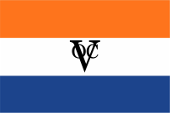
1602–1660,
Flag of the Dutch East India Company,
Source, by: commons.wikimedia.org



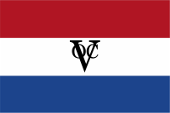
1660–1798,
Flag of the Dutch East India Company,
Source, by: commons.wikimedia.org



History:
The Dutch East India Company (Dutch: Vereenigde Oostindische Compagnie; Vereenigde Geoctroyeerde Oostindische Compagnie, VOC) was established on 20th of March in 1602 and became one of the most important trading companies in the 17th and 18th centuries. The Dutch government handed over to it some sovereign rights, so for war, for built of fortifications, for land acquisition and also some trading monopolies. The Dutch East India Company acquired and operated numerous bases in Asia, e.g.: Batavia (Jakarta) in today's Indonesia, Deshima (Japan), Persia, Chinsura in Bengal in today's Bangladesh and India, Ceylon (Sri Lanka), Formosa (Taiwan), Cape Town in today's South Africa and Cochin in the south of today's India. After some defeats in the Fourth Anglo-Dutch War (1780-1784), the company lost its importance and became dissolved in 1798. The flag of the Dutch East India Company showed the colors of the Netherlands, in thze middle white stripe added by the logo of the company, formed from the initials of the official Dutch name: VOC
Source, by: Wikipedia (DE)

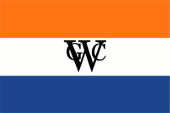
1621–1660,
Flag of the Dutch West India Company,
Source, by: commons.wikimedia.org



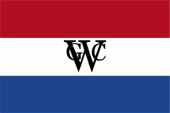
1660–1791,
Flag of the Dutch West India Company,
Source, by: commons.wikimedia.org



History:
The Dutch West India Company (Dutch: Geoctroyeerde West India Company, WIC) was established on 3rd of June in 1621 and became one of the most important trading companies in the 17th and 18th centuries. The Dutch government handed over an exclusive trade patent (monopoly) to trade in West Africa and the Americas. The Dutch East India Company acquired and operated numerous bases in Africa and America, e.g .: New Netherland, Dutch Guiana, Dutch Brazil and some fortified trading posts on the Gold Coast. Focus of the company was the slave trade. In 1661 Dutch Brazil get lost after 30 years of war, and in 1674 also New Netherland. In 1717 and in 1720 Frederick William I., King of Prussia, sold its African possessions to the Company. In 1734 the trade monopoly was abolished, then there were financial problems, and the company was dissolved in 1791. The flag of the Dutch West India Company showed the colors of the Netherlands, in thze middle white stripe added by the logo of the company, formed from the initials of the official Dutch name: GWC
Source, by: Wikipedia (DE)

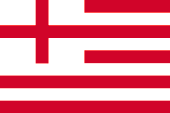
ca. 1615–1707,
Flag of the English East India Company,
Source, by: commons.wikimedia.org



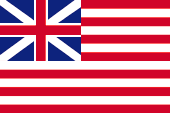
1707–1801,
Flag of the British East India Company,
Source, by: commons.wikimedia.org



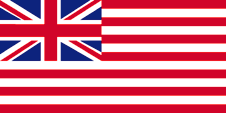
1801–1874,
Flag of the British East India Company,
Source, by: commons.wikimedia.org



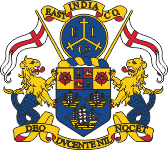
1600–1698,
Coat of arms of the English East India Company,
Source, by: Wikipedia (EN)
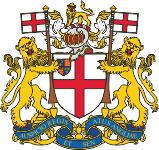
1698–1874,
Coat of arms of the English (British) East India Company,
Source, by: commons.wikimedia.org
History:
The British East India Company (BEIC), to 1707 called English East India Company (EIC), was founded on 31st of December in 1600 and became one of the most important trading companies. The English (British) government handed over to it an exclusive trade patent (monopoly) for trade between the Cape of Good Hope and the Strait of Magellan. In 1661 The English Crown granted to the company extensive sovereign rights, like civil justice and military violence, a little later the rights for built of fortifications, recruiting and the right of coinage were added. In India were established permanent offices, so in 1612 in Surat, 1639 in Madras, 1668 in Bombay, later also acquired extensive properties, so in Bengal and Binar and on the east and west coasts. In 1813 the trading privileges were abolished, and in 1858 the sovereign rights in India were ceded to Great Britain. In 1874 the company of was disbanded. The flag of the British East India Company was emerged from that of the English East India Company. The number of stripes was raised and the flag of England in the upper corner was replaced by that of Great Britain. Sometimes is conjectured, the flag of the British East India Company was the model for the flag of the United States.
Source, by: Wikipedia (DE)

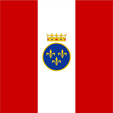
1664(?)–1794(?),
Flag of the French East India Company,
Source: Picaballo, CC BY-SA 3.0, via Wikimedia Commons



History:
The French East India Company existed from 1664 to 1719, trading in spices, tea, coffee, medicines, cloth, porcelain and silk and maintaining factories and colonies on the coasts of Africa, Madagascar in Réunion, on the coast of the Arabian Peninsula, on islands in Southeast Asia, in China and Japan, in Haiti and Louisiana and on the coast of India (e.g. Pondicherry and Chandernagor). In 1719, all the French Trading Companies (Mississippi Company, French West India Company, French China Company, etc.) were merged to form the French India Company (Compagnie des Indes), was taken over and dissolved by the King of France in 1769, was re-established in 1785 and was bankrupt in 1794.
Source, by: Wikipedia (EN)

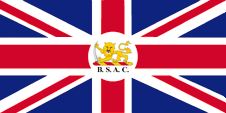
1892–1924,
Flag of the British South Africa Company,
Source, by: Wikipedia (EN)



History:
The British South Africa Company (BSAC or BSACO) was founded in 1889 by Cecil Rhodes and Alfred Beit in London, where the company had its seat. Its actions were colonial exploitation and management of southern Africa. Thus, the Company sold mainly in Rhodesia (Zambia and Zimbabwe) mineral rights. In 1889 the British government awarded it with a letter of protection (Royal Charter) extensive sovereign rights in the administration of Matabeleland, Mashonaland and Manicaland. Only the foreign relations had been reserved for Great Britain; from 1899 it was expanded by West Rhodesia (Barotseland), and from 1900 by West Rhodesia. In 1924 the BSAC was deprived of their sovereignty in Northern Rhodesia by Great Britain and the the country's administration became subordinated under a governor. In 1964, the company ceded its mineral rights to the government of Zambia, and in 1965 the BSAC became merged with other companies to the "Charter Consolidated Ltd.", which was renamed in 1993 to "Charter plc." The flag of the British South Africa Company showed the image of the flag of Great Britain, but in the middle - on a white disk - added by the logo of the company.
Source, by: Wikipedia (DE)

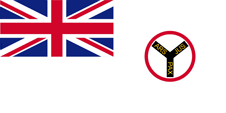
1879–1929,
Flag of the Royal Niger Company,
Source, by: Wikipedia (EN)



History:
The Royal Niger Company was founded in 1879 as United African Company and was granted a Royal Charter of Protection in 1888 and was renamed in Royal Niger Company (RNC). Its task was the economic development of the area that is now Nigeria. However, in 1899 it had to cede all lands, property rights and sovereign rights to the British government. In 1929, the RNC became part of the United Africa Company, which was taken over by Unilever in the 1930s and continued to exist until 1987.
Source, by: Wikipedia (EN)

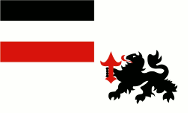
1885–1914,
Flag of the German New Guinea Company,
Source: Jolle [GFDL oder CC-BY-SA-3.0], via Wikimedia Commons



History:
The New Guinea Company was founded in 1882 in Berlin, where the company had its seat. Its actions were colonial exploitation and management of colonial possessions in the Pacific (New Guinea, Bismarck Archipelago and Solomon Islands). The German government gave in 1885 with a letter of protection extensive sovereign rights for the development and administration of the northeast of New Guinea (Kaiser-Wilhelm-Land and the Bismarck Archipelago). In 1886 it became extended by North Solomons, only the external relations has been reserved for the German Empire. The highest authority of the company was the Landeshauptmann. The New Guinea Company came into financial trouble, so that the German Empire was forced to take over and repurchase the sovereign rights, so that from 1899 no longer reigned a Landeshauptmann, but an imperial governor. The company lost all their possessions in the course of expropriation and expulsion of the Germans from New Guinea during and after the First World War. The flag of the New Guinea Company showed a solid white bunting, and in the upper corner of the then flag of the German Empire, and in the flying end a black lion passant guardant.
Source, by: Wikipedia (DE)

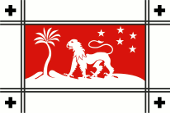
1885–1895,
Flag of the German East Africa Company (DOAG),
Source, by: Flags of the World



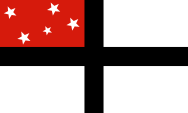
1895–1920,
Flag of the German East Africa Company (DOAG),
Source, by: Flags of the World



History:
In 1884 was founded the Society for German Colonization (GfdK) by Count Behr-Bandelin and Carl Peters in Berlin. Carl Peters traveled together with Joachim Count of Pfeil, Karl Ludwig Jühlke and August Otto to East Africa and visited the hinterland of the possessions of the Sultan of Zanzibar opposite of Zanzibar Island, and purchased protection contracts from local chiefs in the regions of Usegua, Nguru, Usagara and Ukami. For them the could have a letter of protection with sovereign rights from the imperial government. After the issuance of the letter of protection Carl Peters founded on 2nd of February in 1885 the German East Africa Company. Its field of activity was the colonial exploitation and management in East Africa. When it came to uprisings under Zanzibar's coastal residents in 1888, the German Empire took over all sovereign rights in German East Africa in 1890. The company lost all its possessions in the course of expropriation and expulsion of the Germans from German East Africa during and after the First World War. The flag, created in 1885, was white with a red center field separated from the white edge by black double lines that extended to the edge of the flag. In the red center field, a stylized landscape appeared in white with a lion, a palm tree and the five stars of the Southern Cross. The corners of the flag showed four black Greek crosses with bars of equal length. In 1895 a new flag was adopted for the company. It is called the Carl Peters flag or Peter's flag, after Carl Peters, the founder of German East Africa. This flag was plain white with a continuous black bar cross and a red upper corner, which displayed the constellation of the "Southern Cross" using five white stars.
Source, by: Wikipedia (DE)


1887,
Flag of the Jaluit Company,
Source, by: Wikipedia (DE)



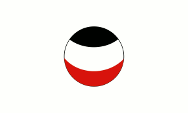
1888–1914,
Flag of the Jaluit Company,
Source, by: Wikipedia (DE)



History:
The Jaluit Company was founded in 1887. Its field of activity was the colonial exploitation and management in the Pacific (Marshall Islands, Gilbert Islands and Carolina Islands). As direct freehold the company acquired the atolls of Jaluit, Bigar, Ujelang and Kili. The main factory was on Jabor Island in the Jaluit Atoll. The German government gave in 1888 with a letter of protection extensive sovereign rights for the development and administration of the Marshall Islands, only the foreign relations had been reserved for the German Reich. The German Reich announced the letter of protection in 1906 and handed over the islands as District of Jap to the colony of German New Guinea. The company lost all their possessions in the course of expropriation and expulsion of the Germans from German New Guinea during and after the First World War. The flag of the Jaluit Company was initially a solid red bunting with the initials of the society in white. From 1888, the flag of the company showed the colors of the German Empire on a disc in the middle of a plain white flag.
Source, by: Wikipedia (DE)

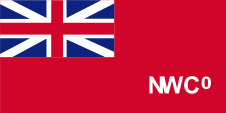
1783–1801,
Flag of the North West Company,
Source, by: Wikipedia (EN)



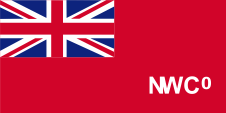
1801–1821,
Flag of the North West Company,
Source, by: Wikipedia (EN)



History:
The North West Company (NWC) was established in 1783 as a trading company for furs and as a competition to the Hudson's Bay Company (HBC), which spread outside the catchment area of the Hudson Bay in northwestern and western direction from the Great Lakes into today's Canada. The competition with the HBC was so hard, that at the beginning of the 19th century arose even armed conflicts between the two companies. The British government ended the conflict in 1821, by forcing of the dissolution of the NWC and melting with the HBC.
Source, by: Wikipedia (DE)

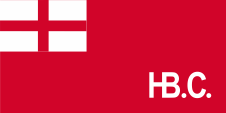
1682–1707,
Flag of the Hudson’s Bay Company,
Source, by:
Wikipedia (EN),
canadashistory.ca



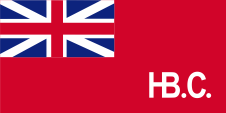
1707–1801,
Flag of the Hudson’s Bay Company,
Source, by:
Wikipedia (EN),
canadashistory.ca



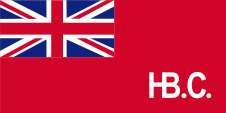
1801–1965,
Flag of the Hudson’s Bay Company,
Source, by:
Wikipedia (EN),
canadashistory.ca




since 2013,
Flag of the Hudson’s Bay Company,
Source, by: Wikipedia (EN),
hbcheritage.ca,
Unknown authorUnknown author,
Public domain, via Wikimedia Commons



History:
The Hudson's Bay Company (HBC) was established in 1670 as a trading company for furs, for the catchment area of the Hudson Bay. The English (British) government handed over to it an exclusive trade patent (monopoly) and granted to the company extensive sovereign rights. The competition to the North West Company (NWC), founded in 1783, became so hard, that at the beginning of the 19th century arose even armed conflicts between the two companies. The British government ended the conflict in 1821, by forcing of the dissolution of the NWC and melting with the HBC. In 1867 was formed the Confederation of Canada (Dominion of Canada), and in 1869 the Hudson's Bay Company (HBC) had to surrender all its territorial and sovereign rights to Canada and in 1870 were sold all territorial possessions to Canada. The company was transformed into a warehouse with many branches and exists until today. With the introduction of the maple leaf flag for Canada in 1965, the Red Ensign was also abolished for the HBC flag.
Source, by: Wikipedia (DE)


![]()

























